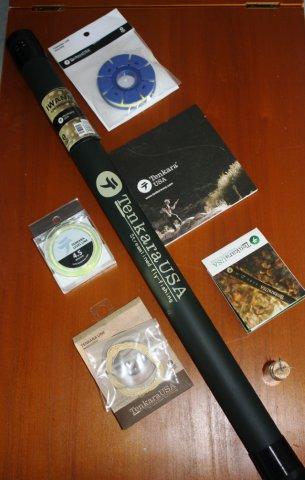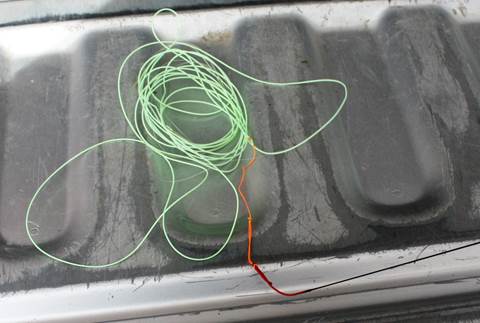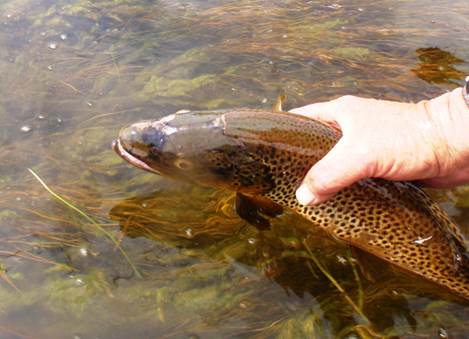TENKARA
Learning the Methods of the Ancient Masters
When I first read the works of Dame Juliana Berners, Colonel Robert Venables, Charles Cotton, James Chetham and Richard Bowlker I marveled at their abilities to take trout using wooden fly rods that were twelve to twenty feet in length and by using a fixed length of braided horse hair fly line and leader.
As I began my studies of fly fishing history in a more serious manner I marveled anew at the modern methods of approach and presentation that these ancient anglers described, in one of my earlier fishing journals I found an entry wondering how I might better understand those ancient angler by fishing their methods with a fixed length of line and a long fly rod. It would be years before I realized the goals in that early journal entry.

I started hearing about the Tenkara Rods and methods of fishing before I had seen one of the rods and to be perfectly honest I was really wasn't interested in fishing a rod with a fixed length of fluorocarbon monofilament line. Now I am not saying that traditional Tenkara fishing is without merit but I am saying that I am not interested in fishing in that way. Each form of fly fishing has its own followers and that is the way it is supposed to be.
I have read and heard anglers talk of the Tenkara Rod and how the fishing offered by these rods are simpler and more back to basics. Personally I don't believe that is entirely true.
If you use the Tenkara in the traditional manner on small streams and with the fluorocarbon monofilament that they were first marketed with, then yes it is simpler as the angler has less tackle to deal with and has fewer casts to master. There still is angle of presentation and approach issue to deal with, however with a fixed length of line these issues are fairly easily solved if common sense it used.
However if you choose to use a floating line, as I do, and fish the spring creeks of Paradise Valley, the streams of Yellowstone National Park and tailwaters like the Big Horn River then I believe that fishing a Tenkara Rod is more complex and challenging than fishing with a conventional single handed modern rod and reel outfit. That was the way I choose to use the Tenkara rod which brings the fishing back to less tackle but as for the fishing being simple that is "Bull".
Last summer I was given a Tenkara Rod to play with and was asked to impart my feelings about the rod and share my thoughts fly fishing with a long rod and a fixed length of line.
Now any time I test or research tackle, flies or methods I am all in and try to do so with an open mind. Furthermore I admit to being somewhat obsessed when I begin a project of this type and this project was to be no exception. However, the project was to take me in a direction that I hadn't foreseen and I have become an advocate of fly fishing with Tenkara Rods but not necessarily in the traditional Tenkara method.
To begin with I set out to learn about the history of Tenkara Rods and the fishing methods and flies developed for this type of fly fishing. I checked some of the information available on-line and by plugging Tenkara into a search engine I came up with 455,000 results. I checked out some of the sites and gathered some information which I will impart. The rising popularity of Tenkara Fly Fishing cannot be under stated, there many blogs and on-line articles dealing with the subject and as with any fly fishing method that rises from obscurity the curiosity of fly fishers has been overwhelming and this method of fly fishing continues to grow. But where did this form of fly fishing begin?
The true origins of Tenkara fishing are truly shrouded in the mist of time, did it originate in China and travel to the lowlands of Japan and then into the mountains or did it start in Japan independent of other area? The true origins are shrouded by the mists of time and it is possible that the first few Tenkara anglers may have been illiterate or perhaps had no interest in writing of their methods and accomplishments. It has been reported that Tenkara fishing was developed in the early days of the nineteenth century (1880's), though it is possible that this form of fishing is older, however scholars are still investigating and studying its origins.
Remember, in the west the origins of fly fishing goes back to 200 A.D. and for many centuries anglers used long rods with fixed lengths of lines attached to the tip of the rod. Is there a connection? Only time and the extensive work of historians will reveal the answer to that question. In Dr. Andrew Herd's The History of Fly Fishing, 2nd Edition, updated and revised published in 2011, he states that "It seem probable that fly fishing was known in Japan as early as the late eighth or ninth centuries BC." I believe that once all of the writings of China are researched and translated that much of the early history of fly fishing will once again be revised.
The Tenkara Fishing, the rods, lines and flies that originated in Japan and were first reported by Mr. Ernest Satow, who was a British diplomat stationed in Japan during the 1870's. His comments can be found in a volume entitled "Diary of climbing Mt. Tateyana," andif you wish to read his comments an on-line PFD version can be found and downloaded at the Tenkara U.S.A web-site. There is also a report written by George E. Gregory on March 28th, 1877 which was titled "Japanese Fisheries" where he described five methods of fishing, though there is some disagreement on whether he actually described Tenkara fishing.
All the other volumes on Tenkara Fishing have been done by Japanese's authors and have yet to be translated, however there are some good DVD's out describing the Tenkara methods and the Tenkara Flies.
Tenkara flies are somewhat different as many of the wet flies are tied with the hackle facing forward this type of hackling is worth investigating with conventional soft hackles! After gaining a working knowledge of the methods and history of Tenkara Fishing I began my own experiments.
First I tried the Tenkara with the fixed length of fluorocarbon and a couple of traditional Tenkara style soft hackle flies and yes the method and the flies work but I was still not thrilled with this form of fishing. However, as I thought about the rod I realized that by using a floating fly line and expanding the use of the Tenkara Rod to the spring creeks of Paradise Valley, the Big Horn, Yellowstone River and the waters of Yellowstone National Park I would be able to fish and better understand the methods employed by those ancient anglers.
At this juncture I will point out that Tenkara Fishing in the United Kingdom quickly made the connection between the Tenkara Fishing methods and the methods used by Charles Cotton, Robert Venables and James Chetham. As a matter of fact one of the on-line sites spends considerable time reviewing the work of James Chetham who authored "The Angler's Vade Mecum" which was published in 1681. By pointing out this connection I do not intend to demean the accomplishment of the Tenkara Anglers but to point out that throughout the world there are many fine anglers who are always thinking and seeking knowledge. Here in American we often forget that fly fishing is practiced worldwide and there is much information of which we are unaware of however the gap is slowly closing with the advent of the Internet.

The first thing that I did was to quickly reread the texts of those ancient anglers and then I looped the braided line attached to the rod, then I constructed a floating fly line from the running line of an old weight forward six weight line that I was replacing. At this point I didn't know if the running line would work or perhaps I should use the forward section of a weight forward three weight, however the long and the short of it was that the floating running line worked just fine. I attached a loop to the back of the line so I could use a loop to loop system in attaching the line to the rod.
I created two lines, the first was eighteen feet in length to which I attached a four foot tapered 4X leader to the front of the line using a needle knot and then I could add a 4X, 5X or 6X tippet of twenty four inches as needed this gave me a total length of twenty four feet.
The second line was twenty two feet in length with a four foot tapered 2X leader to which twenty four inch tippets of 2X, 3X or 4X could be added as needed giving this line a total length of twenty nine feet. These line lengths are within acceptable limit of both the modern and the ancient recommendations for twelve foot rods.
Then I proceed to practice casting and presentation methods using these two lines ever mindful of the methods and advice of those ancient anglers of long ago. However I was using the same flies that I might use with a conventional modern fly rod.
I became fascinated with using the Tenkara rod for a number of reasons, first is the reach that is afforded by the twelve foot rod and the ability to reach into areas that are impossible to accomplish with a conventional rod. Secondly, the slow and soft casts allowing the flies to be placed in the proper position. Thirdly, because you are limited by the length of the rod and line you must approach slowly and carefully and pay a great deal of attention to the approach, the angle of presentation and thinking about the position of the rod during the drift so you can set the hook at the proper time by lifting the rod or moving the rod tip.

Tenkara caught Brown Trout
In becoming proficient in these methods I discovered the pace of my fishing slowed down and that I was enjoying the challenge of each individual trout just a little more. I showed this method to several of my clients and some were eager to try this method while others showed no interest at all.
One of my clients on the Big Horn told me that though the Tenkara Rod and style of fishing was interesting, he frankly wasn't interested, as the approach to each individual trout would slow down his catch rate.
This statement is not unusual with a certain segments of the modern anglers who have come to equate success with the number of fish taken (landed) during any given outing, rather than the contest between the individual trout and the angler. This is not a judgment of the modern angler rather it is an observation.
The modern angler can stand in one place and often cast to several different feeding trout using varying casts of 20, 25, 30, and 35 feet and so on. Where the angler using a Tenkara rod must approach and target a specific feeding trout. This admittedly takes more time and on waters like the Henry's Fork, Big Horn and Missouri Rivers the number of trout taken in a given outing may be slightly less than those using a conventional fly rod system. On smaller streams where there is minimal wading this is much less of an issue.
Of course the modern angler must adapt to the hook set with the Tenkara Rod and since there is no off hand on the fly line the hook set is done entirely with the Rod. The angler must learn how to fight the trout on the Tenkara Rod, this is done by letting the trout run first in one direction and then changing the angle of pull and allowing the trout to run in the other direction, you play this back and forth game until the trout is properly subdued and can be landed and released. A very long handled net will assist you in landing the trout or you can beach them.
Now I am not advocating that all anglers should get rid of their conventional systems and fish only with Tenkara Rods, what I am saying is that you should strive to master the methods used with Tenkara Rods as I use than as it will give you a better insight and understanding the methods and practices of those ancient anglers and will thus improve your abilities to fish with a conventional system. Furthermore there are situations where the Tenkara Rods and methods will allow you to take trout that you are unable to reach with a convention fly rod.
As I reflect on my experiences with the Tenkara Rod and I contemplate the writings of those ancient anglers another factor is brought to mind and I am convinced that those ancient anglers fished both wet flies and flies on the surface (dry flies) upstream, downstream and across stream as the situation dictated.
Unfortunately their accomplishments were later discounted by individuals who, in the name of the sport, set rules as to when dry flies or wet flies were used depending on the direction of the cast or the fact that the dry fly was properly false cast before the presentation. Why this was done will be tackled in another article as it is a complete subject in its own right.
Another factor that comes to mind is that the use of the Tenkara Rod allows the modern angler to better understand the statements made by those ancient anglers and brings to mind a more complete understanding of some those famous quotes.
The classic example is the famous quote by Charles Cotton which is "To Fish Fine and Far Off". What this meant to Cotton during the time of fixed length of line and long rods is one thing. What it has come to mean to modern anglers is something totally different.
In closing I urge you to obtain a Tenkara Rod and explore the possibilities that these rods can offer the anglers.
Enjoy & Good Fishin'
Tom Travis
